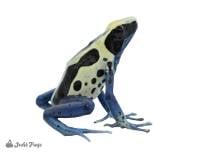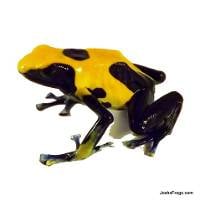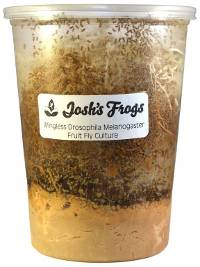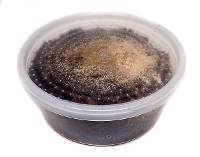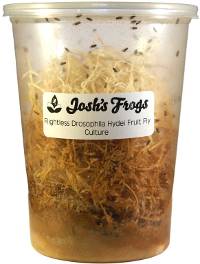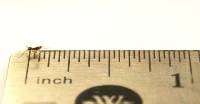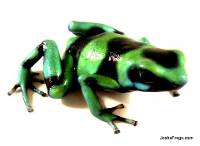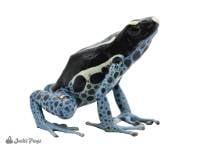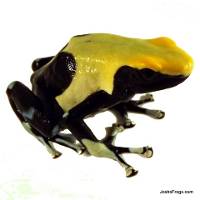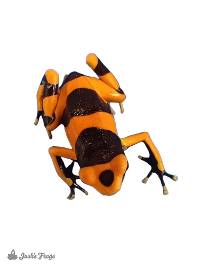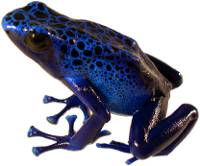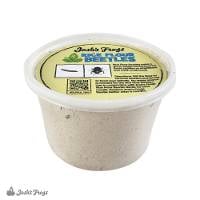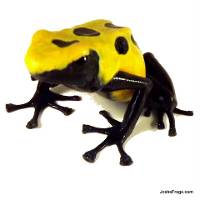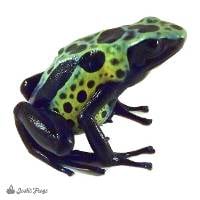Josh's Frogs
Dendrobates tinctorius 'Brazilian Yellow Head' (Captive Bred) - Dyeing Poison Arrow Frog
Dendrobates tinctorius 'Brazilian Yellow Head' (Captive Bred) - Dyeing Poison Arrow Frog
$49.99 0.0 out of 5 stars
(0)
0.0 out of 5 stars
(0)About This Product
Defining Characteristics:
- Great beginner frog
- Contrasting coloration
- Bold
- Easy to breed
- Quiet call
- Very large
- Can be kept in groups when young
- Best kept in pairs as adults
Name: Dendrobates tinctorius 'Brazilian Yellow Head'. In the past, they have been referred to as Dendrobates tinctorius 'Brazilian Cobalt'. In the hobby, these poison dart frogs are commonly called Brazilian Yellow Head tincs, or simply Brazilian Yellow Heads or BYHs. In the 1990s, these were sometimes called Brazilian Cobalts, due to their appearance.
Recommended Vivarium Size: A 10 gallon aquarium is suitable for a single Dendrobates tinctorius 'Brazilian Yellow Head', but Josh's Frogs recommends a 20H or 18x18x18 Vivarium for 1-3 frogs. Not sure how to set up a vivarium? Please watch our video on How to Set Up a Vivarium.
Temperature: They can tolerate a temperature range of 65 F to 80 F, but prefer temperatures in the low to mid 70s. Temperatures over 85F are dangerous.
Humidity: Like most poison dart frogs, Brazilian Yellow Heads prefer a humidity range of 70 – 100%, but can tolerate humidity down to 50% for short periods of time if the frogs have access to water. Low humidity levels, especially without access to water, can quickly be fatal.
Size: These are a medium sized Dendrobates tinctorius, fitting right inbetween Suriname Cobalts and French Guiana Dwarf Cobalts. Adult female Brazilian Yellow Head tincs are larger, measuring in at approximately 2 inches. Male Brazilian Yellow Head tincs are a bit smaller, averaging about 1.5 inches at maturity. All of the Dendrobates tinctorius 'Brazilian Yellow Head' froglets Josh's Frogs sells are well started juveniles, and measure at least 5/8” long.
Age: Dendrobates tinctorius 'Brazilian Yellow Head' is capable of living well over 20 years in captivity under ideal conditions, although a lifespan of 10 years is more common. In the wild, it is thought that tincs may live 4-6 years. All BYHs for sale at Josh's Frogs are well started juveniles, and are 2-3 months old.
Feeding: Like most poison dart frogs, Brazilian Yellow Heads prefer smaller foods. All of the Brazilian Yellow Head tincs Josh's Frogs sells will readily eat Drosophila melanogaster fruit flies. Adult Dendrobates tinctorius 'Brazilian Yellow Head' will readily consume Drosophila hydei fruit flies and pinhead crickets. All ages of poison dart frogs will enjoy springtails and isopods. All feeder insects should be dusted with a vitamin/mineral supplement. For more information on what poison dart frogs can eat, please visit our How-To Guide on Feeding Poison Dart Frogs.
Sexing: Dendrobates tinctorius 'Brazilian Yellow Head' is not sexable until 10-12 months of age. Male Brazilian Yellow Heads tend to be smaller than females, which often appear both longer and wider. Males also tend to have wider front toe pads and a less defined back arch than females. Josh's Frogs sells 2-3 month old juveniles that are not sexable unless otherwise noted. For more information on sexing poison dart frogs, please visit our How-To Guide on Sexing Poison Dart Frogs.
Color/Pattern: All Dendrobates tinctorius 'Brazilian Yellow Head' are mostly black in color with a varying degree of yellow or orange crest on their head, that can extend along the back and down to their sides. BYHs tend to also have very lightly colored toetips. Josh's Frogs does not recommend, support, or endorse line breeding as we believe this leads to weaker captive animals and nature has done a wonderful job of creating an amazing variation in color and pattern of poison dart frogs already.
Social Behavior: These frogs do well housed in groups up to sexual maturity, as long as enough space is provided. Josh's Frogs recommends approximately 10 gallons per frog. As they reach sexual maturity at 10-12 months of age, the social dynamic in a group of Dendrobates tinctorius may change, and all but one female may need to be removed. Female D. tinctorius may fight with each other over a mate. For that reason, many breeders recommend keeping Brazilian Yellow Heads in pairs as adults. Josh's Frogs strongly recommends against housing different species/morphs of dart frogs - for the health of your pets, please avoid mixing! Josh's Frogs recommends purchasing multiple frogs if you are interested in breeding them – this greatly increases the chances of getting a pair.
Breeding: Brazilian Yellow Heads are a bit more difficult to breed than other tincs, but are pretty straightforward to breed if kept seasonally. Like most Dendrobates tinctorius, Brazilian Yellow Heads are best bred in pairs as adult females may fight with each other in the presence of a male. After a dry period of reduced humidity followed by a few weeks of increased feedings and mistings, eggs are deposited on a smooth broad leaf, or on a petri dish under a cocohut. The eggs hatch into tadpoles, which then take 60-80 days to complete metamorphosis into miniature versions of the adults. For more information on breeding and raising poison dart frogs, please visit our How-To Guide on Breeding Poison Dart Frogs.
Natural Range: Dendrobates tinctorius 'Brazilian Yellow Head' hails from Brazil, of course. Where exactly is not know, although BYHs are thought to occur in the Amapa District near Villa Nova.
History in the Hobby: Dendrobates tinctorius 'Brazilian Yellow Head' is a bit of a mystery in the US hobby. First brought into the US in the mid 1990s, animals in the hobby are reported to descend from the Aquarium of the Americas and Paul Miles, an importer who brought in a lot of tinctorius out of Suriname. How did a frog native to Brazil come to be exported out of Suriname? Many native peoples (the same responsible for collecting dart frogs and bringing them to the exporters) do not recognize national boundaries, and could easily have collected these frogs then brought them back into Suriname. Otherwise, it's anyone's guess.
Links of Interest:
Tinctorius Morphguide - includes coverage of Brazilian Yellow Heads
Dendrobard.com thread about BYH keeping and Breeding
Still not sure if Dendrobates tinctorius 'Brazilian Yellow Head' from Josh's Frogs are the right poison dart frog for you? Read the reviews below and see what other customers are saying!
Shipping
After placing an order containing a live animal, you will receive a scheduling email containing our JotForm scheduling link to schedule your new pet's delivery date.
With this scheduling link, you will be able to schedule your order's delivery up to 30 days in advance. You will be able to choose a date of delivery for Tuesday-Saturday (Saturday arrival depends on the carrier's service availability) with the estimated time of arrival generally being 12pm, or 4:30pm for more rural areas. Overnight lows must be above 40°F to ship directly to you (or above 30°F for FedEx Ship Center pickups) as well as below 90°F by estimated time of arrival.
If you require further assistance, or prefer to talk to one of our Customer Service agents, please feel free to reach out to our [email protected] email or our phone line 1-800-691-8178.
Other Customers Also Bought
Customer Reviews
0.0 out of 5 stars
Review data
5 star reviews
- 0%
4 star reviews
- 0%
3 star reviews
- 0%
2 star reviews
- 0%
1 star reviews
- 0%

